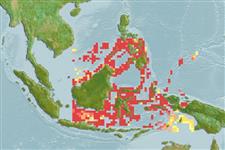Common names from other countries
Environment: milieu / climate zone / depth range / distribution range
Ecologie
. Tropical; 23°C - 30°C (Ref. 102835); 13°N - 9°S, 109°E - 139°E (Ref. 106696)
Western Central Pacific: Restricted in the tropical western Pacific. From Sabah, Malaysia to Palau, north to Philippines and south to Indonesia.
Length at first maturity / Size / Gewicht / Leeftijd
Maturity: Lm ? range ? - ? cm Max length : 41.1 cm SHL mannelijk/geslacht niet bekend; (Ref. 117184); common length : 20.0 cm SHL mannelijk/geslacht niet bekend; (Ref. 348)
Its shell is thinner and smoother than that of H. hippopus, usually devoid of pigmentation, and more semi-circular in profile. The mantle is similar to that of H. hippopus (Rosewater, 1982), except that prominent papillae line the margins of the incurrent siphon.
Collected for food and shell (Ref. 348).
Life cycle and mating behavior
Geslachtsrijpheid | Voortplanting | Kuitschieten | Eieren | Fecundity | Larven
Broadcast spawners. Life cycle: Embryos develop into free-swimming trocophore larvae, succeeded by the bivalve veliger, resembling a miniature clam (Ref. 833).
Poutiers, J.M. 1998. (Ref. 348)
Status op de Rode Lijst van het IUCN (Ref. 130435: Version 2024-1)
Status bij CITES (Ref. 108899)
Not Evaluated
Gevaarlijk voor mensen
Harmless
Gebruik door de mens
Visserij: commercieel
FAO - Aquacultuur: production; | FishSource | Sea Around Us
Tools
Internet-bronnen
Estimates based on models
Weerstandsvermogen
laag, minimale populatieverdubbelingstijd 4,5-14 jaar (K=0.13).
Kwetsbaarheid
Moderate to high vulnerability (51 of 100).
Prijsklasse
Unknown.
